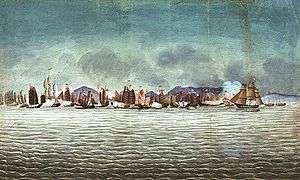HMS Hyacinth (1829)
 Hyacinth and Volage engage Chinese war junks, 3 November 1839 | |
| History | |
|---|---|
| Name: | HMS Hyacinth |
| Ordered: | 10 June 1823 |
| Builder: | Plymouth Dockyard |
| Cost: | £17,361 including fitting[Note 1][1] |
| Laid down: | March 1826 |
| Launched: | 6 May 1829 |
| Commissioned: | 12 January 1830 |
| Fate: |
|
| General characteristics [1] | |
| Class & type: | Favorite-class ship sloop |
| Tons burthen: | 429 40/94 bm |
| Length: |
|
| Beam: | 30 ft 9 in (9.4 m) oa |
| Depth of hold: | 12 ft 9 in (3.9 m) |
| Sail plan: | Full-rigged ship |
| Complement: | 125 |
| Armament: |
|
|
|
HMS Hyacinth was an 18-gun Royal Navy ship sloop. She was launched in 1829 and surveyed the north-eastern coast of Australia under Francis Price Blackwood during the mid-1830s. She took part in the First Opium War, destroying, with HMS Volage, 29 Chinese junks. She became a coal hulk at Portland in 1860 and was broken up in 1871.
Design and construction
Hyacinth was the second of four Favorite-class ship sloops, which were a ship-rigged and lengthened version of the 1796 Cruizer-class brig-sloop. All four ships of the class were ordered on 10 June 1823 and Hyacinth was laid down at Plymouth Dockyard in March 1826. She was launched on 6 May 1829 and commissioned for the West Indies Station on 12 January 1830.[1]
Dimensions
Hyacinth measured 109 ft 6 in (33.4 m) along the gun deck by 30 ft 9 in (9.4 m) in the beam, and had a tonnage of 429 40/94 bm.[1] She was flush-decked with a small forecastle and quarterdeck.
Armament
She was armed with sixteen 32-pounder carronades and two 9-pounder bow chaser guns.[1]
Service
During her 42-year career, she was stationed in the West and East Indies from 1829–41, took part in the First Opium War from 1841–42, and from 1843-46 was stationed off the west coast of Africa in the suppression of the slave trade. After being reduced to 14 guns in 1848,[1] she later became a coal hulk at Portsmouth before being broken up in 1871.[1]
Notes
- ↑ A total cost accounting for inflation of approximately £1,364,500 in today's money.
References
- Winfield, Rif & Lyon, David (2004). The Sail and Steam Navy List: All the Ships of the Royal Navy 1815–1889. London: Chatham Publishing. ISBN 978-1-86176-032-6. OCLC 52620555.
External links
- Career of HMS Hyacinth at William Loney website
- "HMS Hyacinth at the naval Database website". Retrieved 2011-09-11.
| ||||||||||